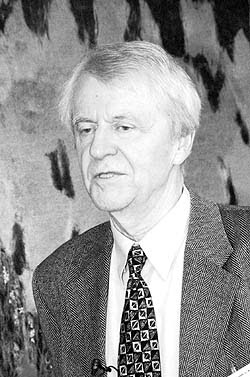Azimuthal anisotropy in Cu plus Au collisions at root s(NN)=200 GeV
Author
| Adamczyk L. | AGH University of Science and Technology, Poland |
| Lednický Richard, promovaný fyzik DrSc. dr. h. c. | Institute of physics of the ASCR, JINR Dubna |
| et al. | different institutions |
Year
2018
Scientific journal
Physical Review C, 98 (1), 014915
Web
Abstract
The azimuthal anisotropic flow of identified and unidentified charged particles has been systematically studied in Cu+Au collisions at root s(NN) = 200 GeV for harmonics n = 1-4 in the pseudorapidity range vertical bar eta vertical bar < 1. The directed flow in Cu+Au collisions is compared with the rapidity-odd and, for the first time, the rapidity-even components of charged particle directed flow in Au+Au collisions at root s(NN) = 200 GeV. The slope of the directed flow pseudorapidity dependence in Cu+Au collisions is found to be similar to that in Au+Au collisions, with the intercept shifted toward positive pseudorapidity values, i.e., the Cu-going direction. The mean transverse momentum projected onto the spectator plane < p(x)> in Cu+Au collision also exhibits approximately linear dependence on pseudorapidity with the intercept at about eta approximate to -0.4 (shifted from zero in the Au-going direction), closer to the rapidity of the Cu+Au system center of mass. The observed dependencies find a natural explanation in a picture of the directed flow originating partly due the "tilted source" and partly due to the asymmetry in the initial density distribution. A charge dependence of < p(x)> was also observed in Cu+Au collisions, consistent with an effect of the initial electric field created by charge difference of the spectator protons in two colliding nuclei. The rapidity-even component of directed flow in Au+Au collisions is close to that in Pb+Pb collisions at root s(NN) = 2.76 TeV, indicating a similar magnitude of dipolelike fluctuations in the initial-state density distribution. Higher harmonic flow in Cu+Au collisions exhibits similar trends to those observed in Au+Au and Pb+Pb collisions and is qualitatively reproduced by a viscous hydrodynamic model and a multiphase transport model. For all harmonics with n >= 2 we observe an approximate scaling of v(n) with the number of constituent quarks; this scaling works as well in Cu+Au collisions as it does in Au+Au collisions.
Cite article as:
L. Adamczyk, R. Lednický, . et al., "Azimuthal anisotropy in Cu plus Au collisions at root s(NN)=200 GeV", Physical Review C, 98 (1), 014915 (2018)


 MINISTR ŠKOLSTVÍ KE SPOLUPRÁCI ČR S SÚJV
MINISTR ŠKOLSTVÍ KE SPOLUPRÁCI ČR S SÚJV INTEREST JINR, Wave 6
INTEREST JINR, Wave 6 The passing of Ivo Zvára
The passing of Ivo Zvára Call for the projects solved in collaboration with JINR (Projects 3+3)
Call for the projects solved in collaboration with JINR (Projects 3+3)  Call for the Grants of the Plenipotentiary of the Government of the Czech Republic in JINR
Call for the Grants of the Plenipotentiary of the Government of the Czech Republic in JINR Czech Ambassador in Russia visited JINR
Czech Ambassador in Russia visited JINR INTEREST JINR, Wave 5
INTEREST JINR, Wave 5 Russia Visa Centre
Russia Visa Centre Working Stays CR - JINR 2022
Working Stays CR - JINR 2022